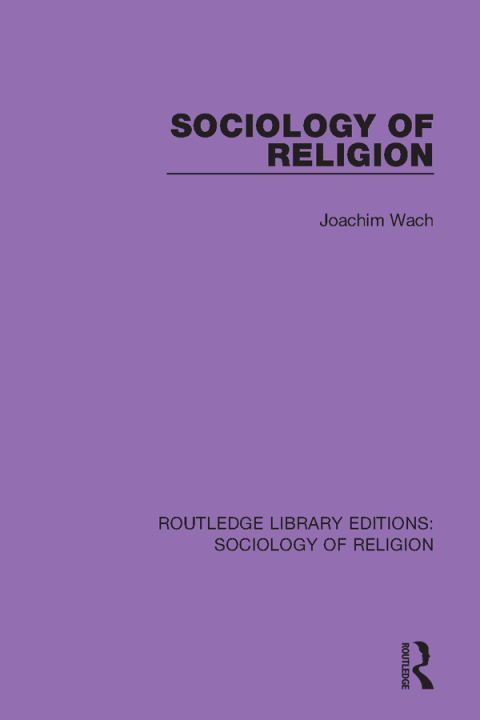Description
Efnisyfirlit
- Cover
- Half Title
- Title Page
- Copyright Page
- Original Title Page
- Original Copyright Page
- Preface
- Table of Contents
- List of Abbreviations
- Part I. Methodological Prolegomena
- 1. The Method
- 1. The Method
- 2. The Field
- 3. Religion and Society
- II. Religious Experience and its Expression
- 1. Religious Experience and its Forms of Expression
- 2. (a) Theoretical Expression: Doctrine
- 3. (b) Practical Expression: Cultus
- 4. (c) Sociological Expression: Communion; Collective and Individual Religion
- III. Sociological Consequences
- 1. The Sociological Function of Religion
- 2. (a) The Integrating Power of Doctrine
- 3. (b) The Integrating Power of Worship
- 4. Religious Experience and the Attitude towards the “World”
- 5. Universal Order and Society; Ethics; Ideal and Reality
- Part II. Religion and Society
- IV. Religion and Society. I. Religion and Natural Groups
- 1. Identity of Natural and Religious Grouping
- 2. Family Cults
- 3. Kinship Cults
- 4. Local Cults
- 5. Racial Cults
- 6. National Cults
- 7. Cult Associations based on Sex and Age
- 8. Conclusion
- V. Specifically Religious Organization of Society
- 1. A New Principle of Grouping: Specifically Religious Groups
- 2. The Secret Society
- 3. The Mystery Society: Greece and Rome
- 4. The Sampradaya of Hinduism
- 5. The Founded Religion
- 6. (a) The Circle of Disciples
- 7. (b) The Brotherhood
- 8. (c) The Ecclesiastical Body. Church and Churches
- 9. Developments: Constitution; Equalitarian and Hierarchical Ideals
- 10. Reaction: The Protest
- A. Individual and Collective Types of Protest: (a) Catholic, (b) Puritan, (c) Revivalist, (d) Orthodox
- B. Forms of Protest: Individualism; New Grouping
- 11. Sociological Consequence of Protest within: Ecclesiola in Ecclesia
- A. The Collegium pietatis
- B. The Fratemitas
- C. Monasticism. The Order
- 12. Sociological Consequences of Radical Protest: Secession
- A. The Independent Group
- B. The Sect
- VI. Religion and Society. II. Religion and Differentiation within Society
- 1. Simple and Complex Society
- 2. Social Stratification and Differentiation in General
- 3. Social Differentiation in Particular
- 4. Occupational Differentiation in Primitive Society: (a) Australia, (b) Eskimos, (c) South India, (d) New Guinea, (e) Melanesia, (f) American Indians, (g) South Africa, (h) West Africa, (i) East Africa
- 5. Social Differentiation and Religion
- 6. Sociological Consequences. Occupational Associations: (a) Africa, (b) Rome, (c) Islam
- 7. Social Differentiation in Higher Civilization
- A. Religions of the Warrior: (a) Mexico, (b) Mithraism, (c) Zen Buddhism
- B. Religions of the Merchant: Vallabhachari Hinduism, Parsiism, Jainism
- C. Religions of the Peasant: Western Asia
- 8. Social Differentiation in World Religions
- A. Asia
- B. Europe
- C. America
- VII. Religion And Society. III. Religion and the State
- 1. Methodological Approach: Sociological Role of the State
- 2. Beginnings of the State
- 3. Identity of Spiritual and Secular Rule; Holy Law
- 4. Traditional and Founded Religion
- 5. Competition of Cults
- 6. Typology I: Identity of State and Cult
- 7. Examples of a Transitional Stage: (a) Zoroastrianism, (b) Shinto, (c) Islam
- 8. Typology II: The New Faith
- 9. Typology III: Universal Religions
- 10. The Communion of Saints
- 11. The Conquest of the State
- 12. Three Examples: Confucianism, Buddhism, Christianity
- A. Confucianism
- B. Buddhism
- C. Christianity
- VIII. Types of Religious Authority
- 1. The Organization of Religious Groups
- 2. Charisma and Leadership
- 3. The Founder of Religion
- 4. The Reformer
- 5. The Prophet
- 6. The Seer
- 7. The Magician
- 8. The Diviner
- 9. The Saint
- 10. The Priest
- 11. The Religiosus
- 12. The Audience
- IX. Conclusion
- Appendix
- Hierarchy
- Indices
- I. Places and Peoples
- II. Persons
- III. Religious Groups
- IV. Topics






Reviews
There are no reviews yet.